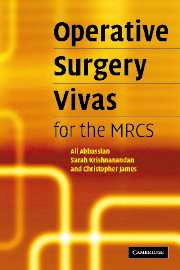Book contents
- Frontmatter
- Contents
- Preface
- 1 The elective repair of an abdominal aortic aneurysm
- 2 Adrenalectomy
- 3 Amputation (below knee)
- 4 Anorectal abscesses, fistulae and pilonidal sinus
- 5 Appendicectomy
- 6 Principles of bowel anastomosis
- 7 Breast surgery
- 8 Carotid endarterectomy
- 9 Carpal tunnel decompression
- 10 Central venous cannulation
- 11 Cholecystectomy (laparoscopic)
- 12 Circumcision
- 13 Colles' fracture (closed reduction of)
- 14 Compound fractures
- 15 Dupuytren's contracture release
- 16 Dynamic hip screw
- 17 Fasciotomy for compartment syndrome
- 18 Femoral embolectomy
- 19 Femoral hernia repair
- 20 Haemorrhoidectomy
- 21 Hip surgery
- 22 Hydrocele repair
- 23 The open repair of an inguinal hernia
- 24 Laparotomy and abdominal incisions
- 25 Oesophago-gastroduodenoscopy
- 26 Orchidectomy
- 27 Parotidectomy
- 28 Perforated peptic ulcer
- 29 Pyloric stenosis and Ramstedt's pyloromyotomy
- 30 Right hemicolectomy
- 31 Skin cover (the reconstructive ladder)
- 32 Spinal procedures
- 33 Splenectomy
- 34 Stomas
- 35 Submandibular gland excision
- 36 Tendon repairs
- 37 Thoracostomy (insertion of a chest drain)
- 38 Thoracotomy
- 39 Thyroidectomy
- 40 Tracheostomy
- 41 Urinary retention and related surgical procedures
- 42 Varicose vein surgery
- 43 Vasectomy
- 44 Zadik's procedure
14 - Compound fractures
Published online by Cambridge University Press: 16 October 2009
- Frontmatter
- Contents
- Preface
- 1 The elective repair of an abdominal aortic aneurysm
- 2 Adrenalectomy
- 3 Amputation (below knee)
- 4 Anorectal abscesses, fistulae and pilonidal sinus
- 5 Appendicectomy
- 6 Principles of bowel anastomosis
- 7 Breast surgery
- 8 Carotid endarterectomy
- 9 Carpal tunnel decompression
- 10 Central venous cannulation
- 11 Cholecystectomy (laparoscopic)
- 12 Circumcision
- 13 Colles' fracture (closed reduction of)
- 14 Compound fractures
- 15 Dupuytren's contracture release
- 16 Dynamic hip screw
- 17 Fasciotomy for compartment syndrome
- 18 Femoral embolectomy
- 19 Femoral hernia repair
- 20 Haemorrhoidectomy
- 21 Hip surgery
- 22 Hydrocele repair
- 23 The open repair of an inguinal hernia
- 24 Laparotomy and abdominal incisions
- 25 Oesophago-gastroduodenoscopy
- 26 Orchidectomy
- 27 Parotidectomy
- 28 Perforated peptic ulcer
- 29 Pyloric stenosis and Ramstedt's pyloromyotomy
- 30 Right hemicolectomy
- 31 Skin cover (the reconstructive ladder)
- 32 Spinal procedures
- 33 Splenectomy
- 34 Stomas
- 35 Submandibular gland excision
- 36 Tendon repairs
- 37 Thoracostomy (insertion of a chest drain)
- 38 Thoracotomy
- 39 Thyroidectomy
- 40 Tracheostomy
- 41 Urinary retention and related surgical procedures
- 42 Varicose vein surgery
- 43 Vasectomy
- 44 Zadik's procedure
Summary
Why are compound fractures of significance?
A compound or open fracture is important as it signifies a greater degree of soft-tissue damage that needs urgent assessment and may require reconstructive surgery in the future. A compound fracture has a much greater risk of complications such as infection, delayed or non-union.
What is the initial management of a patient with a compound fracture?
Many patients with compound fractures also have significant other injuries and maybe in shock. A thorough advanced trauma life support assessment to identify and correct any life-threatening injuries should be the first step. Other specific measures include:
Assessment and documentation of the wound. Ideally a photograph should be taken, the wound covered with a sterile dressing and left undisturbed until the patient is in theatre. A wound swab may be taken prior to dressing.
Assessment and documentation of the neuro-vascular status of the limb.
Intravenous prophylaxis antibiotics.
Tetanus prophylaxis.
Analgesia.
Splintage of the affected limb (Thomas' splint, Plaster of Paris, etc.).
Radiographs of the limb and the surrounding joints are obtained in two views.
Describe Gustilo's classification of open fractures
Type I Small, clean, puncture wound (<1 cm) as a result of a low energy injury with little soft-tissue damage
Type II The wound is >1 cm but again the degree of soft-tissue damage is low
Type III These are as the result of high-energy trauma with extensive soft-tissue damage and contamination:
Type IIIA adequate bony cover can be achieved
Type IIIB there is comminution, periosteal stripping and bone loss and the wound is heavily contaminated
[…]
- Type
- Chapter
- Information
- Operative Surgery Vivas for the MRCS , pp. 49 - 52Publisher: Cambridge University PressPrint publication year: 2006



